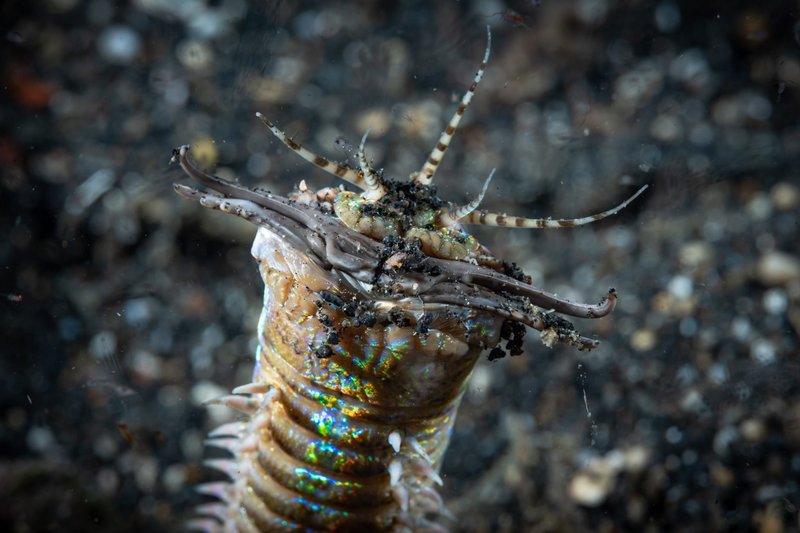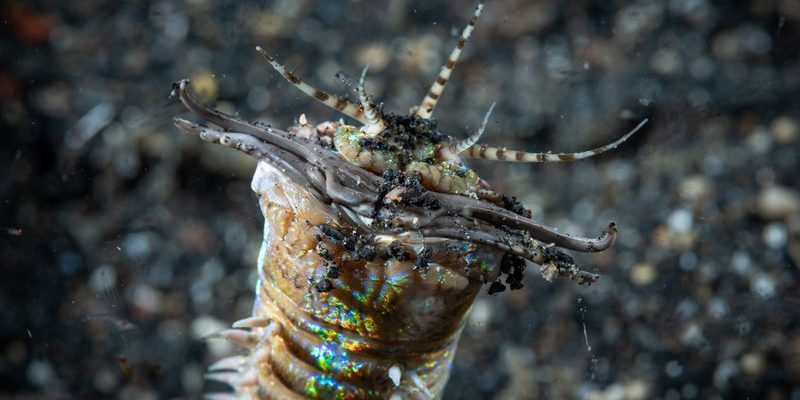
You might relate to the way Bobbit worms operate. Just like we might pull the shades when we want to relax or avoid loud noises during study time, these intriguing creatures have their own preferences. They’re not just about their striking looks; their behavior can tell us a lot about how they survive in their natural habitat. So, grab a cup of coffee, and let’s explore the enigmatic lives of Bobbit worms!
What Are Bobbit Worms?
Bobbit worms, known scientifically as *Eunice aphroditois*, are marine polychaete worms that can grow up to 10 feet long. They live mostly in soft substrates like sand or mud, where they can easily hide. The name “Bobbit worm” comes from a rather infamous incident involving a certain Mrs. Bobbitt, but we’ll stick to the worm for now!
These worms have vivid colors, often displaying greens, blues, and reds, which can be quite the sight. They have a unique body structure, divided into segments, with a series of bristles that help them move through their environment. Most importantly, they have powerful jaws, making them fierce predators despite their relatively small size compared to many ocean creatures.
Understanding what Bobbit worms are helps us better appreciate their behaviors, especially when it comes to light and movement. So, what do they really think about these elements in their environment?
Bobbit Worms and Light: Are They Photophobic?
You might be curious whether Bobbit worms avoid light. The answer is a bit nuanced. These worms are generally nocturnal, meaning they are most active at night. During the day, they tend to stay hidden in their burrows, which can be several feet deep. This habit makes it seem like they’re afraid of light.
Here’s the thing: it’s not that they’re scared of light; it’s just safer for them. In their natural habitat, exposure to light can signal potential predators. So, they instinctively retreat to darker spaces to avoid being seen. This behavior is common among many marine creatures, especially those that are prey to larger fish and other predators.
You might picture a Bobbit worm peeking out of its burrow under the moonlight, ready to ambush unsuspecting prey. This stealthy approach helps them survive in the often dangerous ocean environment. It’s not about light per se; it’s about safety and survival.
Movement: Do Bobbit Worms React to Activity?
You might be wondering if Bobbit worms react to movement in their surroundings. The short answer is yes, they do. These worms are highly sensitive to vibrations and movements in the water. When something stirs up the sand or water near them, they can sense it thanks to specialized receptors along their bodies.
Imagine you’re at a party—if someone suddenly bumps into the table, you might jump a little. Bobbit worms react in a similar way. They might quickly retreat into their burrow if they detect nearby movement. This instinctive response helps them avoid potential threats and makes them excellent hunters at the same time.
Interestingly, this sensitivity also plays a role in their feeding behavior. Bobbit worms extend their long bodies out of their burrows, waiting for fish or other small creatures to pass by. When they sense movement, they strike with lightning speed using their powerful jaws. It’s a thrilling spectacle of nature that showcases their adaptability.
Living Conditions: Habitat Preferences
To better understand Bobbit worms, we can look at their preferred habitats. They usually inhabit tropical and subtropical waters around the world, including the Caribbean Sea, Indian Ocean, and parts of the Pacific Ocean. These areas provide the soft substrate they love for burrowing.
Bobbit worms typically live in depths ranging from shallow waters down to several hundred meters deep. They have a preference for sandy or muddy environments, which allows them to dig and create their homes easily. These living conditions not only offer camouflage from predators but also a place to ambush prey effectively.
The unique combination of darkness, substrate, and water movement plays a crucial role in their survival. By adapting to these conditions, Bobbit worms can thrive in environments that might seem inhospitable to other creatures. It’s all about finding the right balance for safety and sustenance.
Bobbit Worm Behavior: Hunting Skills
Let’s dive into how Bobbit worms hunt. As mentioned earlier, these worms are predator masters. Their hunting strategy is fascinating. They can remain completely still for long periods, which allows them to blend into their surroundings perfectly.
When an unsuspecting fish or small marine creature swims by, they can strike with incredible speed—almost startlingly fast. Their jaws can snap shut within milliseconds, grabbing the prey before it even knows what happened. This technique not only highlights their camouflage but also their highly developed hunting skills.
Interestingly, while they exhibit a fear of light and movement, they can also adapt their hunting based on these elements. In darker conditions, they might extend out further from their burrows, whereas in brighter conditions, they might stay hidden. This adaptability shows how these creatures have honed their skills over time to ensure their survival.
Bobbit Worms and Ecosystem Balance
Bobbit worms play a vital role in their ecosystems, contributing to the balance of marine life. By preying on smaller fish and invertebrates, they help control populations and ensure that no single species dominates. This balance is crucial for maintaining healthy coral reefs and marine environments.
Moreover, their burrowing behavior helps aerate the substrate, which can improve the health of the surrounding waters. Healthy ecosystems rely on this interaction between different species. Bobbit worms, despite their somewhat fearsome reputation, contribute positively to their habitats.
If you think about it, they’re like the unsung heroes of the ocean floor. While they might look intimidating, they’re simply fulfilling their role in the broader tapestry of marine life.
Challenges Facing Bobbit Worms
Like many marine species, Bobbit worms face challenges due to human activities. Ocean pollution, climate change, and habitat destruction can significantly impact their populations. Increased sedimentation from coastal development can bury their habitats, making it difficult for them to thrive.
Overfishing in some regions can also reduce their prey populations, causing a ripple effect throughout the ecosystem. As we continue to learn more about these amazing creatures, it becomes increasingly important to take steps to protect their habitats.
We can all play a part by supporting sustainable seafood practices and advocating for cleaner oceans. Every little bit helps, and by taking care of our oceans, we can ensure that Bobbit worms and countless other marine creatures can continue to thrive.
Final Thoughts
Bobbit worms are truly fascinating creatures that teach us a lot about adaptation and survival in the ocean. While they might avoid light and react to movement, these behaviors are key to their hunting strategies and overall existence. By understanding them better, we can appreciate the intricate balance of marine ecosystems and why each creature plays an essential role.
As you explore the world of marine life, keep an eye out for these unique worms. They might just be hiding in plain sight, ready to surprise you with their extraordinary skills and stunning colors. Whether you’re a marine enthusiast or just curious about the ocean, the Bobbit worm is a reminder of how diverse and captivating our natural world can be.

